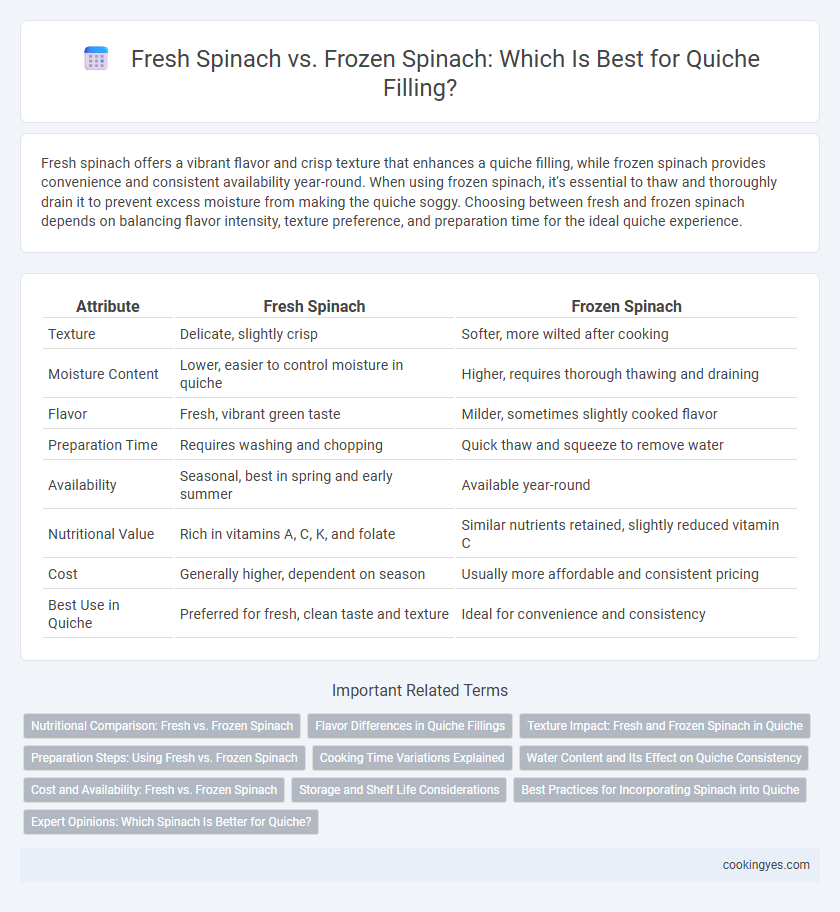Fresh spinach offers a vibrant flavor and crisp texture that enhances a quiche filling, while frozen spinach provides convenience and consistent availability year-round. When using frozen spinach, it's essential to thaw and thoroughly drain it to prevent excess moisture from making the quiche soggy. Choosing between fresh and frozen spinach depends on balancing flavor intensity, texture preference, and preparation time for the ideal quiche experience.
Table of Comparison
| Attribute | Fresh Spinach | Frozen Spinach |
|---|---|---|
| Texture | Delicate, slightly crisp | Softer, more wilted after cooking |
| Moisture Content | Lower, easier to control moisture in quiche | Higher, requires thorough thawing and draining |
| Flavor | Fresh, vibrant green taste | Milder, sometimes slightly cooked flavor |
| Preparation Time | Requires washing and chopping | Quick thaw and squeeze to remove water |
| Availability | Seasonal, best in spring and early summer | Available year-round |
| Nutritional Value | Rich in vitamins A, C, K, and folate | Similar nutrients retained, slightly reduced vitamin C |
| Cost | Generally higher, dependent on season | Usually more affordable and consistent pricing |
| Best Use in Quiche | Preferred for fresh, clean taste and texture | Ideal for convenience and consistency |
Nutritional Comparison: Fresh vs. Frozen Spinach
Fresh spinach contains higher levels of vitamin C and certain antioxidants that degrade during freezing, while frozen spinach retains comparable amounts of iron, calcium, and fiber due to the quick-freezing process. The freezing preserves essential nutrients, making frozen spinach a convenient and nutritious option for quiche filling without significant loss of minerals. Selecting fresh or frozen spinach ultimately depends on convenience, availability, and desired texture in the quiche.
Flavor Differences in Quiche Fillings
Fresh spinach offers a vibrant, slightly sweet flavor that enhances the light and creamy texture of quiche fillings, providing a distinct green taste. Frozen spinach, while convenient, tends to have a milder, more muted flavor due to blanching before freezing, which can result in a less pronounced spinach presence in the quiche. The choice between fresh and frozen spinach ultimately impacts the quiche's overall flavor intensity and texture consistency.
Texture Impact: Fresh and Frozen Spinach in Quiche
Fresh spinach offers a tender, slightly crisp texture that enhances the quiche filling with vibrant green color and a delicate mouthfeel. Frozen spinach, when properly thawed and drained, provides a softer, more uniform texture, contributing moisture that can result in a creamier filling but risks a soggy crust if not managed carefully. Choosing between fresh and frozen spinach depends on desired texture balance and handling techniques to maintain quiche structural integrity.
Preparation Steps: Using Fresh vs. Frozen Spinach
Fresh spinach requires thorough washing, trimming, and sauteing to remove excess moisture before adding to quiche filling, ensuring a crisp texture. Frozen spinach must be fully thawed and squeezed to remove all water to prevent a soggy crust and watery filling. Both preparation methods affect the quiche's final consistency and flavor, with fresh spinach offering a firmer bite and frozen spinach providing convenience.
Cooking Time Variations Explained
Fresh spinach requires a shorter cooking time for quiche filling, typically sauteed for about 2-3 minutes until wilted. Frozen spinach, often pre-cooked and drained, needs minimal defrosting but may release excess moisture, necessitating thorough squeezing and sometimes an additional minute of cooking to prevent sogginess. The difference in cooking times affects texture, with fresh spinach providing a firmer bite, while frozen spinach tends to blend more uniformly into the quiche.
Water Content and Its Effect on Quiche Consistency
Fresh spinach contains higher water content, which can make quiche filling watery and affect the overall texture by making it less firm after baking. Frozen spinach releases excess moisture upon thawing, requiring thorough drainage to avoid sogginess and maintain a creamy consistency. Properly managing the water content ensures the quiche retains a well-structured, smooth filling with balanced moisture.
Cost and Availability: Fresh vs. Frozen Spinach
Fresh spinach typically costs more per pound and is available seasonally or from local markets, impacting quiche preparation depending on supply. Frozen spinach offers year-round availability at a lower price point, making it a cost-effective choice for consistent quiche filling. The texture and moisture content differ, with frozen spinach requiring thorough thawing and draining to prevent soggy quiche crusts.
Storage and Shelf Life Considerations
Fresh spinach offers a shorter shelf life of about 3 to 5 days in the refrigerator, requiring quick use for quiche filling to maintain optimal texture and flavor. Frozen spinach, stored at 0degF (-18degC), lasts up to 8 to 12 months and provides convenience and consistent availability, though it releases more water, often necessitating thorough draining before use. Proper storage impacts the filling's moisture content and overall dish quality, making frozen spinach ideal for long-term planning and fresh spinach preferable for immediate preparation.
Best Practices for Incorporating Spinach into Quiche
Fresh spinach offers a vibrant flavor and tender texture ideal for quiche filling, but must be thoroughly wilted and drained to prevent excess moisture from making the crust soggy. Frozen spinach, already cooked and squeezed dry, provides a convenient, consistent option that reduces prep time and moisture content for a firmer quiche base. Using either form, ensure spinach is well-drained and chopped finely to evenly distribute the greens and maintain the desired quiche consistency.
Expert Opinions: Which Spinach Is Better for Quiche?
Experts recommend fresh spinach for quiche filling due to its vibrant flavor and firm texture, which holds up well during baking. Frozen spinach, while convenient, tends to release excess moisture that can make the quiche watery unless thoroughly drained. Culinary specialists emphasize choosing fresh spinach to achieve a richer taste and optimal consistency in quiche dishes.
Fresh spinach vs Frozen spinach for quiche filling Infographic

 cookingyes.com
cookingyes.com